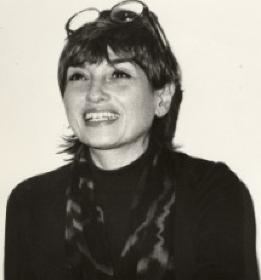Nationality American Name Shirley Gorelick | Died October 19, 2000 | |
 | ||
Born 24 January 1924 ( 1924-01-24 ) Brooklyn, NY Known for Painting, drawing, sculpture printmaking | ||
Shirley Gorelick (24 January 1924 – 19 October 2000) was an American painter of psychological realism. Neither a devoted photo-realist nor an expressionist, she used all sources of information, working from photos, the live model, and her own sculptures made from life studies, to get as close to the core of her subjects as possible.
Contents
- Early work 1950s and 1960s
- Realist work 1970s and 1980s
- Womens cooperative galleries
- Works in public collections
- References

Her daughter, Jamie Gorelick, served as Deputy Attorney General of the United States from 1994 to 1997.
Early work (1950s and 1960s)
Born Shirley Fishman, she married Leonard Gorelick in 1944. Shirley Gorelick earned her B.A. at Brooklyn College and her M.A. at Teachers College, Columbia University. In the late 1940s, she studied briefly with Hans Hofmann in Provincetown. She subsequently explored various media, including painting in oils and acrylics, intaglio printmaking, drawing in silverpoint, and sculpting in terra cotta, stone, and wood. Although influenced by the prevailing Abstract Expressionism of the 1940s and 1950s, she soon became uncomfortable with the distortion of the figure in modern art and began to work her way back to realism. In the mid-1960s, she re-imagined canonical works like Pablo Picasso's Les Demoiselles D'Avignon (1907) and Giorgione's Concert Champêtre. Her Homage to Picasso I (1965), for example, uses figures with real volume instead of fracturing them into Cubist facets.
Realist work (1970s and 1980s)
In the early 1970s, while working on a series called The Three Graces, Gorelick turned her focus to representations of a female African-American model. She painted and etched a series of works depicting the model and her interracial family. At the same time, she completed the powerfully individualized Willy, Billy Joe, and Leroy (1973), a trio of African-American men posed in the artist's studio with an earlier painting as the backdrop.
Gorelick's subsequent Three Sisters series (1974–77), based on models ranging in age from seventeen to twenty-one, is a blunt, honest portrayal of female adolescence. It is totally different from the stereotype of a nubile Lolita. The young women, robed and nude, in a leaf-patterned garden, are shown filled with varying degrees of pain, questioning, anger, and confusion, which are communicated by nuances of position, gesture, or facial expression. As described by the curator and critic Lawrence Alloway in 1977, Gorelick's work had taken on " a new lyrical undercurrent. This comes through most fully in a large painting of 'Three Sisters', each one of whom appears twice, once nude, once loosely robed. Thus three become a crowd, but the echoes of paired likeness and familial resemblance imply a pattern of kinship. The girls, all posed toward the spectator, stand in a garden, ankle deep in leaves, against an overgrown wall."
In 1976, Gorelick painted a nine-foot portrait of Frida Kahlo for The Sister Chapel, a feminist collaboration by thirteen artists which celebrated female role models. Gorelick appropriated a number of elements from Kahlo's own paintings, as well as photographs that were taken of the Mexican painter. By this time, Gorelick's work was recognized for her use of "all sources of information," including photos, models, and xeroxes, "to get as close to the core of her subjects as possible."
In the late 1970s, Gorelick turned to representations of middle-aged couples, either together or individually, as in Gunny and Lee I (1977), The Barnetts (1979–80), Tess in a Blue Dress (Dr. Tess Forrest) (1980), and Dr. Joseph Barnett I (1981). Gorelick's imperious Tess in a Blue Dress (Dr. Tess Forrest), a portrait of a psychoanalyst, shows the sitter in her office with a backdrop of books.
Women's cooperative galleries
Gorelick was a member of SOHO 20 (est. 1973), an all-women cooperative gallery in New York. Though not one of the founding members, she joined the group for the start of its second season in 1974. She was also a founding member of Central Hall Artists Gallery (est. 1973) in Port Washington, New York.
